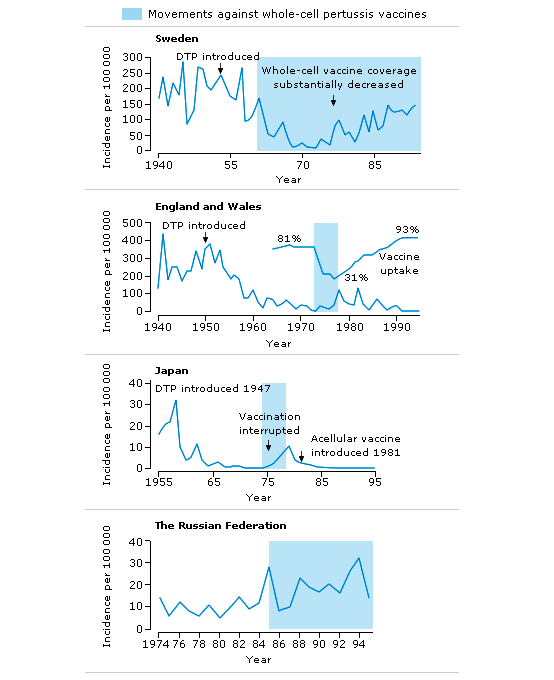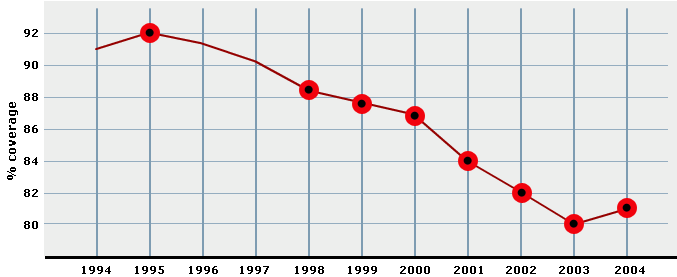Impact of rumours and crises
The history of immunization is not only characterized by its unique success at achieving huge reductions in mortality (deaths) and morbidity (illness and disability) from vaccine-preventable infections and the global eradication of smallpox. It is also notable for the emergence of vaccine sceptics who firmly believe that vaccines are harmful and lobby against them. This – often very vocal – opposition has been a persistent challenge to immunization programmes since they first began over two centuries ago.90
Example 1: Whole-cell pertussis "scare"
Many recent immunization programmes have suffered setbacks from immunization scares. Children have been needlessly put into danger by frightened parents that refused immunization for their children after "scare stories" about particular vaccines.
The graphs illustrate the impact of rumours about the pertussis whole-cell vaccine from about 1960 onwards in four different locations. Note how affected the vaccine coverage entails a rise in the incidence of pertussis.
These examples also show how negative beliefs about a particular vaccine can spread around the world and reduce public confidence in its safety.

Example 2: MMR and autism controversy in the UK
In 2008, 14 years after the local transmission of measles was halted in the UK, the Health Protection Agency for England and Wales declared it had once again become endemic, i.e. continuously circulating in the population. This was seen as a result of almost a decade of low MMR vaccination coverage across the UK.
Burgess, Burgess and Leask54 (2006) analysed how a report of a hypothesised link between measles-mumps-rubella vaccination and autism![]() AutismA chronic neural development disorder usually diagnosed between 18 and 30 months of age. Symptoms include problems with social interaction and communication as well as repetitive interests and activities. At this time, the cause of autism is not known. in 1998 became a major public health issue in the United Kingdom, leaving most experts surprised by its overwhelming influence on public opinion about MMR vaccination. Effectively communicating with parents of autistic children and members of the general public who believed that the truth about the vaccine was being concealed would have been critical to avoid the reduction of vaccination coverage.
AutismA chronic neural development disorder usually diagnosed between 18 and 30 months of age. Symptoms include problems with social interaction and communication as well as repetitive interests and activities. At this time, the cause of autism is not known. in 1998 became a major public health issue in the United Kingdom, leaving most experts surprised by its overwhelming influence on public opinion about MMR vaccination. Effectively communicating with parents of autistic children and members of the general public who believed that the truth about the vaccine was being concealed would have been critical to avoid the reduction of vaccination coverage.

Health-damaging outcomes of negative rumours are not confined to high-income countries. There are many other cases from all over the world. For example, in 2009, the death of a 7-year-old child in Taiwan, following his vaccination against the H1N1 strain of influenza virus, led to rumours that the vaccine was responsible. These rumours were followed by a 30% drop in the number of children receiving it.
Question
Which of the following statements would you think to be the main reason for less tolerance towards vaccines, making them more likely to be the subject of negative rumours and "scare stories" than is the case for medical drugs?
| A. Vaccines are more expensive than many drugs which creates less tolerance in the public’s perception. | |
| B. Public tolerance towards adverse reactions is lower compared to side-effects of drugs as vaccines are given to healthy people. | |
| C. Parents consenting to vaccinating their child, perceive a harm possibly linked to a vaccine as more grave because it could have been avoided. | |
| D. The public awareness towards vaccine preventable diseases in industrialized countries is high, leading to a resentment towards vaccines. |
Statements B and C are correct.
A vaccine reaction or immunization error means that a previously healthy person was subjected to some form of harm as a result of the immunization. By contrast, medical drugs are given to people who are already sick, to make them better. This difference results in a much lower public tolerance to adverse reactions of vaccines than there is to the side-effects of drugs.
Most vaccine recipients are babies and young children who were vaccinated with their parents' consent; any harm that occurs following an immunization is seen as "avoidable" by parents because the vaccine could have been refused. There is much less tolerance for instances of avoidable harm than there is for adverse events that could not be avoided.
Due to a decline of childhood infections in industrialized countries the threats to health and life posed by once-common vaccine preventable diseases (measles, polio, pertussis, diphtheria and tetanus) is low. The benefits of vaccination are no longer being reinforced by directly experiencing the diseases that vaccines prevent.

